Manuscript Addition: (1907) 1s[t] edn. £48
Editorial Note (page ornament): Scroll-patterned box ornament; imprint of the Modern Master Draughtsmen
series
DRAWINGS OF D. G. ROSSETTI
Note: Heavy brown laid paper
Note: Heavy brown laid paper with drawing loosely attached
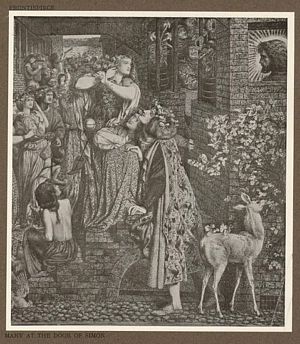
MARY AT THE DOOR OF SIMON
Photo, Mansell
Figure: ‘The scene represents two houses opposite each other, one of which is that
of Simon the Pharisee, where Christ and Simon, with other guests, are seated at table. In
the opposite house a great banquet is held, and feasters are trooping to it dressed in
cloth of gold and crowned with flowers. The musicians play at the door, and each couple
kiss as they enter. Mary Magdalene . . . has been in this procession, but has suddenly
turned aside at the sight of Christ, and is pressing forward up the steps of Simon's house,
and casting the roses from her hair. Her lover and a woman have followed her out of the
procession and are laughingly trying to turn her back. The woman bars the door with her
arm. Those nearest the Magdalene in the group of feasters have stopped short in wonder and
are looking after her, while a beggar girl offers them flowers from her basket. A girl near
the front of the procession has caught sight of Mary and waves her garland to turn her
back. Beyond this the narrow street abuts on the high road and river. The young girl seated
on the steps is a little beggar who has had food given her from within the house, and is
wondering to see Mary go in there, knowing her as a famous woman in the city. Simon looks
disdainfully at her, and the servant who is setting a dish on the table smiles, knowing her
too. Christ looks toward her from within, waiting till she shall reach him. A fawn crops
the vine on the wall where Christ is seen, and some fowls gather to share the beggar girl's
dinner, giving a kind of equivalent to Christ's words: “Yet the dogs under the
table eat of the children's crumbs.” ’Description taken from a letter [from DGR] to Mrs. Clabburn referring to the
unfinished oil replica, July 1865. (
Pall Mall Budget, 22 Jan 1891, p.
14.)qtd. in Surtees, p. 62
Editorial Note (page ornament): Woman painting, accompanied by cherub.
DRAWINGS OF
ROSSETTI
LONDON. GEORGE NEWNES LIMITED
SOUTHAMPTON STREET STRAND
W.C.
NEW YORK. CHARLES SCRIBNER'S SONS
BALLANTYNE PRESS.
LONDON &
EDINBURGH
Editorial Note (page ornament): Text begins with a decorated, boxed capital "T."
BY T. MARTIN WOOD
THE intensely subjective nature of Rossetti's art is what gives it
fascination for its lovers; it belonged to himself. Even in his early period and with his
dramatic subjects this was so, and partly by the depth of imaginative meaning he read into the
faces of women. The last phase of his art was entirely one of self-revelation; his own moments
of sorrow were mirrored in one woman's face, moments in which he created sadly, living over
again in them some hours that had been happy.
- This is her picture as she was :
- It seems a thing to wonder on,
- As though mine image in the glass
- Should tarry when myself am gone.
- for so
- Was the still movement of her hands
- And such the pure line's gracious flow.
- 'Tis she: though of herself, alas!
- Less than her shadow on the grass
-
10Or than her image in the stream.
One might hazard the question whether it were possible for a painter such as Rossetti,
seeking expression in his art for this intensity of feeling, to vie in the rendering of the
external aspects with those painters who have approached life with that cold acuteness to the
appearance of things and aloofness from their meaning characteristic of work that has
contributed largely to the actual science of painting. To Rossetti life came over-crowded,
over-coloured. There was too much for him to realise in his working moments. The very richness
of his nature embarrassed his output. His gifts gave him so many ways of self-expression from
which to choose. The phases through which his genius passed, the result of an inherited and
rare temperament and its adventures, made the science of painting prosaic for him. He himself
felt latterly
that this impatience had left his ideas pathetically at the mercy of
his materials. Apart from the quality in colour to which he attained, one is conscious always
in his paintings of the tragedy of genius striving for expression through an ineffectual
technique. Rossetti's individuality, however, was so strong that it stamped itself everywhere ;
in spite of every limitation his art explains his attitude towards life. In his ability to make
it show this his greatness lies, and in the fact that the point of view that it suggested was
his alone. His art created for itself its own atmosphere—an unfamiliar one at first
to Englishmen, with its subserviency of everything to a romantic emotionalism. The histories of
the world for Rossetti were its stories of emotion, and in every place that his memory knew
Love's image had been set to reign, Love who had wandered down through the ages decked with the
flowers of art, offerings of bygone lovers, dead lovers to never dying Love. As a strange
spirit Rossetti entered modern London. A heart rich from many forgotten experiences seemed to
have lodged itself in him and he painted with eyes filled with the colours of old things. For
him the tapestries could never fade in a room that had known love's history, nor the colours
leave the missal which told the story of a soul.
How far his drawings were intended to foreshadow large paintings which he desired to make as
windows for us to look with him into his romantic country we cannot say. As it is they show
that it was in Rossetti's power to be the greatest imaginative illustrator of his century; that
he was not so seems to prove that in this way, as in some others, he failed to attain to much
that at first had seemed included in his destiny. In his paintings, in his poetry, in these
drawings something there is that was new, and that brought a fresh phase into art and
literature in England. It is something which has influenced permanently the nation's thought
and has been even admitted into the procession of its fashions. For a time women tried to look
as the women in his paintings, so much had the type he chose, which was his own creation,
imposed itself upon their imagination.
The Rossetti woman, if she did not supersede the early Victorian type, at least helped to
change it, and to mark a change which was taking place in the ideals of the nation. Fresh
tendencies in national thought are always correspondingly represented by a change in the type
of women idealised in its art and poetry. When the Victorian type went, the time had passed
when homage was given to women for a surrender of their claims on life. The new type spoke of
the ardent way in which another generation of women was creating for itself wide interests in
the world.
Rossetti displayed in his art the dramatic sense ; we find him in his earlier drawings always
illustrating dramatic subjects, rendering action in his figures in a way that proclaims him at
once as one of those to whom the actions of men, the faces of women, come tragically or
otherwise into every dream. One is enabled to write more clearly on this point by comparing him
with his friend Burne-Jones. Burne-Jones' figures live in a dream in which the world has little
part, whilst Rossetti's dream is of the world itself. His work is rich with the human
experience that is absent in the art of his friend. He is accredited with being the leader of a
phase of decadence, while, as a matter of fact, no one could have heen further removed from
anything like a “decadent” pose. Rossetti had an unconscious and
unexplained sympathy for life that tragically pursued, and found itself shipwrecked upon, its
own illusions. It was part of his art's vitality. There was little defiance in his attitude, it
was altogether one of pity. Indiscriminate publication has familiarised the public only with
the last sad phase of Rossetti's art, and unhappily this is esteemed characteristic. The
intimate patrons of the painter possessed themselves of his early work ; now it is
inaccessible, and it is not at his best that he is seen in any public collection.
It is possible to like the art of Rossetti very deeply, and also to love the changing colours
of the sea and the shadows of the sun clouds moving swiftly on the hills. But often to pagan
lovers of such things the art of Rossetti, shuttered close in its mediæval darkened
rooms, has seemed as an almost poisonous flower, with its forgetfulness of the world without.
It can never be sufficiently emphasised how necessary it is in judging any art first of all
to share some of the mood in which it was created. Those who would enter into the atmosphere of
Rossetti's art must find their way to it in the darkened light of dreams. It stands in no
relation whatever to the workaday world.
A poet whose writings realised an opposite temperament to Rossetti's own would have had the
test of poetry that it could be taken to the fields in the early morning and read. To attempt
to bring a painting of Rossetti's into relationship with nature out of doors would to all
intents put an end to the reason for its artistic existence. It would be to demand of it that
it should strike a note in tune with a mood the direct opposite to that which it was its
intention to create. Though art should always be examined in its own atmosphere, much of the
criticism applied to Rossetti is but the bringing of his art out into the fields. It
is not valuable criticism that approaches work in a spirit of this
kind.
A great deal too much has been made in writing of Rossetti's Pre-Raphaelitism. To a nature
like Rossetti's any school, any methods he may have taken up with, or inspired, would be
largely accidental to his environment. Arrived at a time of reaction, of revolution in English
painting, with his qualities of leadership he threw himself into Pre-Raphaelitism as a new
movement, but it is more than probable his genius would have found methods of expression as
personal to itself in the refinements that entered English painting in the wake of
pre-Raphaelitism,—only the Pre-Raphaelite movement could not have been but for the
ardent genius of Rossetti which poured inspiration into all those who gathered about him. He
departed from Pre-Raphaelite tenets just when it suited him; its hold over him lay chiefly in
that he liked to realise very definitely the shapes of objects in his art, because they made
his dreams real and gave pleasure to those eyes of his that so hungered after every sign of
beauty. The secrets of art lie, after all, more within the vision than in expression. That
Rossetti could have directed his genius into another manner from Pre-Raphaelitism seems
possible from the fact that in his poetry so many styles meet and show his variegated
temperament expressing itself in opposing forms. What was of literary significance in
Rossetti's art perhaps gained from Pre-Raphaelitism, for Pre-Raphaelitism made things
symbolical. To nearly every object that they brought into their pictures the Pre-Raphaelites
gave meaning other than its own, other than that which was simply artistic. Now Rossetti,
looking on his art and its relationship to life from a literary more than from an artistic
standpoint, striving to attain in art not an imitation of life but an expression of his ideas
about it, found, as we have said, painters' problems a difficulty. He was irritated by
difficulties which to a whole-hearted painter present pleasures of conquest in proportion to
their resistance to his craftsmanship and skill. In other ways Rossetti lacked the
characteristics of really great painters as such ; he had not the seeing eye that gives to
every outward thing a shape and colour already formed within the mind. From such a cult of the
eyes as this comes the true painter. By taking thought art does not become a metaphor for
ideas, though the whole aim of its subject may be to make it so. Art is always metaphorical,
whatever its subject and however unconsciously, to itself. The presence of genius only is
needed. Yet because in actual pigment red can never be anything other than red, ideas
are clothed more easily in the colour of words, for in themselves
words have no colour and they have no existence other than the existence which they have in
thought, and the colour which any language lends them.
Rossetti could not learn painting instinctively as he learnt writing ; for him the materials
were not so simple, they remained during a long apprenticeship an obstacle rather than an aid
to impassioned expression, and from his apprenticeship he never emerged into anything
approaching freedom. Upon the vivacity of the imagination in them, and not upon subtlety of
line or of observation, the claims of Rossetti's drawings rest, though it is wonderful how
often he lifts his art up to the level of all that he has to say and imposes upon us a
forgetfulness of its shortcomings. His studies do not reveal a master who looked upon objects
and beautiful forms for their own sake and for the sake of the tender drawing he could find in
them. Rossetti, indeed, loved a visible world, and liked to interpret the beauty of natural
objects, but he was always in haste to get the scene set where such objects were, after all,
for him only as accessories to the thing enacted, or as notes in an orchestration; of value but
not existing by themselves. He gave to every object the import of the drama in his mind; in his
art things seem to have about them the meaning lent them by an imagination that spiritualised
objective things so that they seem there in essence only and rendered with a sympathy that
shows how alive to the significance of outward beauty Rossetti was, and how his own time and
every-day surroundings were fused and blent with his most far-reaching imaginings. To turn to
outward things, and to study them as merely offering various surfaces to the light, holding
depths of shadow, possessing lines of delicate shape, was, however, impossible to his
temperament. The characteristic story of Madox Brown setting in early days the young Rossetti
down to paint such still life as
jam jars, and of the young
painter's impatience, shows that to paint or draw the objects for their own sake only was not
congenial to him. There was very likely sufficient of the true painter in Rossetti to make such
study a delight, had his mind ever been still enough for his hand to playfully carry out such
problems; but always at the back of his mind, at the back of the world for him, a strange drama
of love and beauty went on. How then could time be spent in studying what, after all, were
merely objects, how could time be spent in deliberating over the study of them ? And so the
drawings which Rossetti left us are seldom studies of poses and draperies, such elaborate
scaffolding as
that upon which the art of Burne-Jones was built. They are little
pictures in most cases, in which the pencil or the pen afforded a readier and less laboured
means of realising quickly the life dramatic of imagination.
Illustration essentially suited his genius in so far as in small dimensions it was easier to
reflect easily, whilst the power of creation lasted, what was moving in a mind that was held by
no one mood for long. It suited his genius also because it minimised the labour of creation,
and with Rossetti it was always apparent that creation was a labour. He himself has said in
that other art in which perhaps he always found his happiest expression—
- Unto the man of yearning thought
- And aspiration, to do nought
- Is in itself almost an act,—
- Being chasm-fire and cataract
- Of the soul's utter depths unseal'd.
A body that grew faint under the strain of over-feverish genius undoubtedly imposed its
indolence upon Rossetti's spirit, so that he shirked the difficulties of his earlier subjects
until the downfall of his art set in with the constant production, for indiscriminating
purchasers, of a face that grew more and more distant from the beautiful type of his earlier
inspiration, which till the end he always pathetically imagined himself to be creating.
Turning to the illustrations, that called
A Drawing for a Ballad
, with its free and loose handling, its qualities of selection and emphasis, show how
great in many ways Rossetti was. What lines could be simpler than those in the girl's dress ?
In such a sketch as this, in the little things, Rossetti is masterly, and one cannot here
separate what he has to say from the saying of it. This sketch shows an artist great enough to
be unpretentious, and it shows that the happy qualities of mind, uriited with its craft, sprang
from his habits of thought. We see in it with what natural tenderness he has sketched, how by
one of the girl's hands her companion's face is lifted to the kiss. This naturalness holds the
secret of Rossetti's power. His art was consciously set on decoration, but this is not a
decoration ; in all that he has read into the miniature faces and in the embracing of the
hands, we get in this sketch more intimately than anywhere else evidence of his great heart.
This dramatic sympathy would attract every one could it shine more often through the
carelessness, the unhappiness, that at the end obscured it. In this way we must think of
Rossetti as a failure, and a great man cannot fail once without blinding the world to his many
successes. Had Rossetti possessed
no sense of colour, and had he not completed many large pictures and
elaborate illustrations, but only followed this one path as far as he could go, doing only such
things as this, without being a poet and without being a painter, who knows to what extent we
should have praised him for these slighter things alone? There is no doubt that we expect so
much from him, and he has given us so much in other ways, that we forget the treasures hidden
here. One could wish that he had always worked in his drawings with the freedom indicated in
this sketch, but it was not the fashion then. Work in Rossetti's day had to come into the
market elaborated to the point of its soul's extinction in order to be taken seriously. Now
that we have taught ourselves always to value first any indication of the spirit, what would we
not give to possess. ourselves of work by this artist in impulsive drawings, and it must have
been within Rossetti's power to do them down to the last.
The drawing of the
death of Lady Macbeth is one
of the most wonderful things Rossetti ever did, and it is characteristically marred by
imperfect drawing. The drawing is of great quality throughout, except for the figure with head
averted. Some wonder why the ability to make the rest of the picture perfect failed the artist
here. It is probably because the action of each figure is controlled only by the imaginative
impulse that sways the whole composition, that gives to every part of it dramatic intensity as
if executed all in one mood, bringing in one moment of creation the whole to life on paper.
Those in sympathy with the nature of Rossetti's art do not count this piece of bad drawing a
disastrous flaw. The rarity of genius makes them accept everything gratefully; it disarms a
cavilling attitude. The fault in their eyes even seems to add to the tense note struck as a
changed note in an over sweet harmony. Its dissonance breaks the monotonous rhythmic
decoration, and its harshness relieves the detail so delicately wrought. Rossetti is of the
extreme few who have finished minutely without sacrificing the qualities of greater
significance than finish. His art is great enough to make us forget the detail and to render us
for the time oblivious of it. In our absorption in the subject it seems for a time not to
exist, only the tense mood exists, the intense moment. In a picture in which the moments are
aflame with tragedy Rossetti drew this figure moving slowly and with decorative convention. All
the figures are controlled by such a convention; they are partaking in a high drama. Such a
convention as Irving has in the art of acting gives something to the dignity of tragedy. The
conventions of Rossetti too are so much in the spirit of high
art, they conform so well to the claims of art, that they lend beauty
to that power of his of giving to his drawings dramatic perfection. In regard to the particular
figure of which we write it is better, faulty as it is, than if it had been redrawn in another
mood and given again to the picture. It is to be regretted, of course, that it did not come
rightly as it is, but it is less to be regretted than if he had substituted dead perfection for
living imperfection, a studied and acquired idea of the pose in place of the instinctive one.
The first illustration for
Desdemona's Death
Song
is simply a rough sketch, but even taken as such it shows how blind or how careless
in the matter of form Rossetti at times could be. Here the lower part of the figure is so
obviously lacking in proportion that it prevents us accepting an otherwise characteristic
drawing as such. Still of Rossetti's best moments is the controlling grace of the bend in the
maid's wrist, and the movement of her head as she combs Desdemona's hair. The curtain blown
into the room by the wind is one of those touches Rossetti gives everywhere ; by insistence on
such an incident he makes us live the moments depicted in his pictures-just as we find
ourselves in moments of extreme tension watching eagerly something absolutely trivial and
making some accident portent with meaning.
In the
second and completer study for this
picture
we find the proportions corrected; thought and after-thoughts have developed the
artist's intentions. Desdemona, with her hand hanging thoughtfully, is an improvement on her
attitude at first. The maid, however, has lost much of the spontaneity of her original
gestures.
Like all those in whose art we find phases of an extraordinary beauty Rossetti could often
draw in the most uninspired fashion, presumably where his interest flagged. In the drawing
of
Hamlet and Ophelia, Ophelia is charming; but
it is with difficulty that we are reconciled to the Hamlet; it is difficult even to understand
in what position the figure is standing; not that this indefiniteness often matters in art, but
here, where everything else is so precise, it provokes dissatisfaction. From Rossetti alone
could have come the background with the winding ways parting and meeting rhythmically with
steps up to the bridge. Such architecture as this, and all the quaint furniture in his
pictures, were designed by himself. From his facile imagination anything might come. Certain
objects that were full of associations of old things he returned to often in his drawings, such
as old Books of Hours with all the sentiment that many hands had given to them. The niche in
the picture containing the Crucifix and the Breviaries is significant of the Religion in
Rossetti's art.
This was his religion, to think of Divine things by the legends of a
romantic Church.
In comparing the
study for
Christ at the House of Simon the Pharisee
with the
completed drawing, the
question arises whether, with the elaboration that has come into the latter, some of the
intensity of the study has escaped ; or whether, on the other hand, the subject has gained. The
simplicity of the first undoubtedly possesses something which is subsequently lost in
elaboration, and yet taking the completed picture and looking into it one finds a lesson in
Rossetti's methods. We find that by dwelling upon his subject he has emphasised certain notes,
has repeated as it were a refrain, and made more spirited and poetic in rendering the figure of
the lover in the foreground. After-thoughts have given every touch that could possibly enrich,
and, at the same time concentrate, dramatic motif in this figure. The embroidery on his coat,
the flowers in his hair, the hair itself, and the face so mocking and fascinating and sure of
itself, is more in the spirit of the subject than the gentler face as it appears in the sketch.
The figure of the Magdalene gains in many ways as completed, and though the distressed loving
face and the flowing hair of the
sketch
are changed, the alteration of the expression on the face from one of intense distress to one
of proud determination is very interesting as showing how his subjects grew and changed under
his hand. It is wholly to the gain of the picture the different gesture which he has arrived at
in the
second drawing, where the
Magdalene with both hands throws the flowers from her hair. The dramatic quality upon which we
have insisted as part of Rossetti's art is nowhere better shown than in the deer quietly eating
leaves from the wall, all unconscious that there is acted out beside it the most pathetically
beautiful drama of the world. One misses in the
finished picture some of the sensitive drawing given in the
sketch to the Magdalene's dress. Here, instead, her clothes are
as if she were perfectly still they give no indication of her movements and the stormy action
round her. That is the fault of Pre- Raphaelitism—to fritter away the spirit for the
sake of the embroidery upon the body's clothes: to lose emphasis in elaboration, to sacrifice a
greater beauty for a meaner one.
Certain characteristics that are strongest in Rossetti's art are the outcome of the intensely
human course his imagination took. His drawings are of the kind that one can live with long;
looking into them often one is always rewarded by finding some new thing, and one's thoughts
are ever being arrested by new appreciation of some
quaint conceit. The depths of Rossetti's imagination are such in these
drawings that we may look into them whilst watching the changes of our own thought.
The best that art has given to us has often come from artists in a quite sub-conscious way.
Because Rossetti's genius was so many-sided it is probable that he could explain most of what
he did to himself, and if in the picture of which we have been speaking we take such a thing as
the alterations between the figures in the background, and as they are shown in the sketch, it
will seem apparent that he gave reasons to himself for everything in his compositions, and did
not drift into anything by accident in aiming at design. In the
sketch the nearest figure pursues the Magdalene beckoning, in
the
finished drawing her movements are
arrested, she and the other figures pause before the door, speechless with cynical amusement
and surprise as the Magdalene enters.
You should have wept her yesterday
was done as an illustration to one of his sister's
poems. It represents the return of the Prince after many delays to find his lady has
died, believing him unfaithful. The ugly drawing of the Prince spoils an otherwise beautiful
design. This ugliness is only compensated for by the six girls who turn their pitiful eyes so
naturally from their prayer to look towards the Prince. The grace of girlhood in their faces
must come as a revelation to some of Rossetti's critics.
The
illustration to Tennyson's “Palace of Art” should excite us as curious and beautiful. We have in it one great poet's illustration
for another's poem, made with perfect art. We have in this drawing the echo of the one's
imagination in the other. Rossetti has brought the drawing on to the paper as a dream. An
immense courage is demanded of the artist, when he shall forget his reason for a dream, and
when he has the courage not to reconcile his dream with the demands of the prosaic mind,
demanding only what is prosaic. The lines illustrated are—
- in a clear-wall'd city on the sea,
- Near gilded organ-pipes, her hair
- Wound with white roses, slept St. Cecily
- An angel look'd at her.
The drawing interprets, and it is wonderful that it should do so, the imaginative mood in
which we feel these lines were written. Like music they bring their message in mystical sound.
One accepts their beauty feverishly. In such a mood as they invite reason greets imagination.
The words do not represent things or a place, but a mood and an emotion. In them is just such a
strange and beautiful
medley as music brings to us, as great art always makes reasonable to
us.
One thing we must not forget in criticising Rossetti, and that is that we are speaking of one
who was among the first to enter into the inheritance of his age, that on these grounds his art
is placed amongst the arts which in every age live by reason of their significance.
Commemorated in Grecian art is the perfected form of man as the flower of animal evolution.
With this perfection attained another day of creation was begun and is continued, in which the
things of the spirit are being built up until the perfect spirit is made. And just as it was
long before man so far awoke to a knowledge of the beauty which triumphs in him as to worship
his own shape (placing before himself his own image as the standard to which the gods had led
him, and from which he might not go back without fear of their displeasure) so not everywhere
yet is the spirit of man learning its own beauty from the consciousness of itself to which it
has attained.
Such art as Rossetti's, with its subordination of everything to an emotional and spiritual
motive, does certainly anticipate, as other modern work like the sculpture of Rodin
anticipates, the direction in which the greatness of art in the future must tend. That which is
concerned with character, with all that outwardly gives indication of the soul, has appeared
and re-appeared triumphantly throughout the history of art—a spirit changing its
raiment. The art of Rossetti fails just in so far as its craftsmanship is a failure, but its
imperfections cannot take away its significance. Christianity made the spirit visible and took
serenity from the face of art. To-day Art is spiritualising itself by its refinements. It is
perfecting itself through such an impressionism of the senses as we have in the art of
Whistler, and through the science of the impressionists of France. Their subtleties are based
on the broad truths given by masters long ago, and fearful lest any sources of our inspiration
should be forgotten what is modern in art has in turn assumed almost every antique shape.
An old manner of painting which was great, does not share its greatness with the modern
imitator, but it does not necessarily withhold it from him. Art may clothe itself in some old
style, as Rossetti's did, and what shape it takes, whether based on the old or growing out of
the new, does not matter when it is the messenger of inward things.
And since no beauty of bodily form greater than Grecian beauty, is possible to art, that art
will be great which betrays the spirit's
Editorial Note (page ornament): Page ends with ornament depicting the head of Hermes in profile, wearing a winged
helmet.
flame. The future of life and of art are one. It is inevitable that art shall be
great as the spirit of man grows rich. It is for this that we have left behind the serenity
which was of Greece and of the partly awakened soul.
PERMANENT REPRODUCTIONS OF THE PICTURES AND STUDIES OF DANTE GABRIEL ROSSETTI,
G.F. WATTS, O.M., R.A., AND SIR EDWARD BURNE-JONES ARE PUBLISHED BY FREDK. HOLLYER, 9
PEMBROKE SQUARE, KENSINGTON, W. ILLUSTRATED CATALOGUE 12 STAMPS
![Image of page [21]](http://www.rossettiarchive.org/img/thumbs_small/s255d.wood.jpg) page:
page: [21]
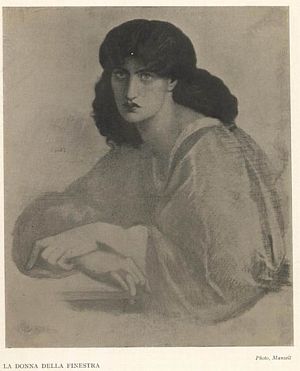
LA DONNA DELLA FINESTRA
Photo, Mansell
Figure: Monogram and date lower left corner: ‘1870’. . . . Finished
drawing (from Mrs. Morris), differing in treatment. Half-length, turned to the left, head
and eyes facing to front, and hands placed upon a ledge in front of her; the heavy dark
hair, fastened behind the ears, lies outspread on the shoulders.Surtees, p. 152
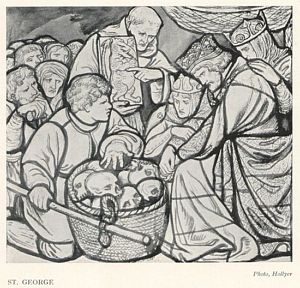
ST. GEORGE
Photo, Hollyer
Figure: Ink design for stained glass; basket of skulls in foreground surrounded by figures,
including seated king at left.
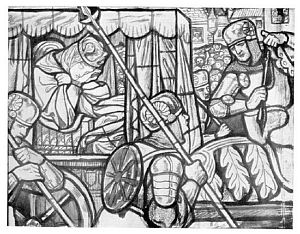
ST. GEORGE
Photo, Hollyer
Figure: Ink design for stained glass; Princess in a palanquin at left with eyes closed and
cheek resting on her crossed hands. Mounted soldier at right, soldier with lance in
foreground, half-figure soldier at lower right.
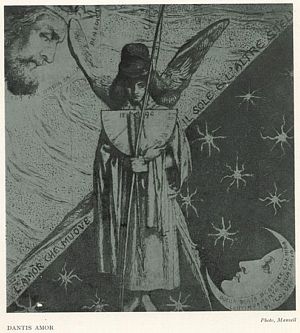
DANTIS AMOR
Photo, Mansell
Figure: Inscribed around the sun: ‘
QUI EST PER OMNIA SAECULA BENEDICTUS’; around the moon: ‘
QUELLA BEATA BEATRICE CHE MIRA CONTINUAMENTE NELLA FACCIA DI CLOUI’; along the diagonal dividing line: ‘
L'AMOR CHE MUOVE IL SOLE E L'ALTRE STELLE’;. . . . Love, dressed as a pilgrim, stands full-face holding a
sundial dated ‘1290’. In the upper left corner the sun (head of
Christ); lower right corner a crescent moon (head of Beatrice). The background is divided
diagonally between the sun's rays and the stars.Surtees, pp. 73-4
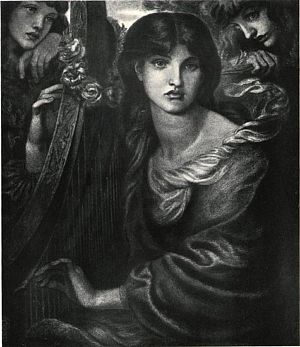
LA GHIRLANDATA
Photo, The Autotype Co.
Figure: Alexa Wilding sitting for the woman, and the angel heads taken from May Morris. . .
. Monogram and date lower left corner: ‘1873’ . . . Finished study
for the picture, lacking only the foliage and foreground flowers.Surtees, p. 130
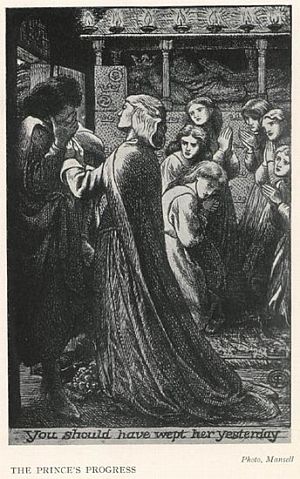
THE PRINCE'S PROGRESS
Photo, Mansell
Figure: The prince is being stopped by a woman. In the background the dead body of the
Princess lies in state under a canopy surmounted by flaming torches; below it six mourning
girls kneel at a praying desk.Surtees, p. 108 Captioned by the line ‘You should have wept her
yesterday’.
Note: Heavy pink laid paper.
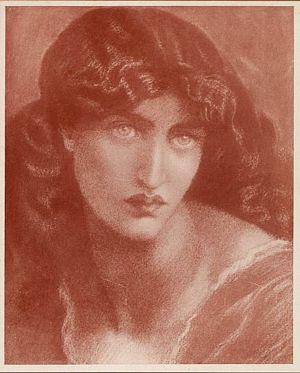
STUDY FOR THE SALUTATION
Photo, Hollyer
Figure: Finished study of Mrs. Morris for head and shoulders of Beatrice. Head almost to
front.Surtees, p. 155
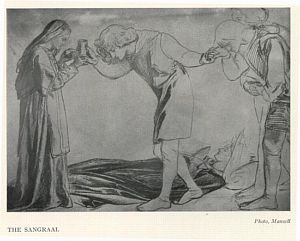
THE SANGRAAL
Photo, Mansell
Figure: Unfinished study with only the five principal figures participating; their
disposition is similar but the action of the two knights is different: Sir Bors lays his
left hand on Sir Percival's left shoulder, while clasping the latter's left hand with his
right. Red chalk outlines for the two circular windows are visible but are disregarded by
the superimposed figures . . . According to W. M. Rossetti the head of the central figure
was done from Swinburne (the likeness is not particularly striking) whom the artist met
for the first time at Oxford while painting the Union murals. The Angel of the Grail bears
the features of Elizabeth Siddal.Surtees, p. 53
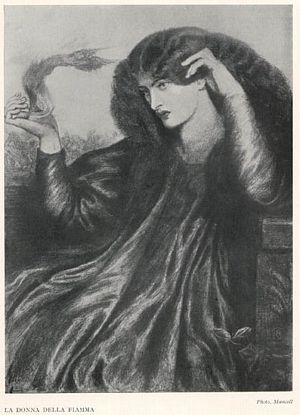
LA DONNA DELLA FIAMMA
Photo, Mansell
Figure: Initials and date lower right, ‘1870’ . . . Finished drawing,
probably a study for a painting which was never realized. The head is taken from Mrs.
Morris; from her right hand issues a winged figure in a flame of fire; on her left wrist
is a circular mark.Surtees, p. 122
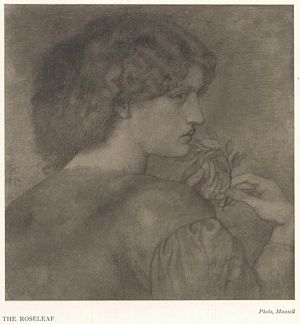
THE ROSELEAF
Photo, Mansell
Figure: Monogram and date left centre: ‘1870’ . . . Head and shoulders
of Mrs. Morris turned to right, holding up a spray of rose-leaf with her right hand and
fingering it with her left.Surtees, p, 122
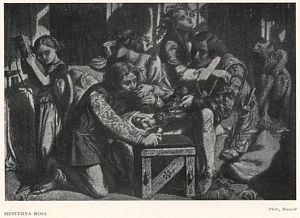
HESTERNA ROSA
Photo, Mansell
Figure: Interior of a tent at dawn after a night of revelry. A child playing upon a lute
stands on the extreme left and on the right a hairy ape is scratching itself (symbols of
innocence and depravity) whilst ‘Yesterday's Rose’ has turned away
her head and hides her face with her right hand.Surtees, p. 21
N.B.: Wood (or Mansell) crops the picture so that the inscriptions along the
bottom do not show. Also, the plate in Surtees shows the addition of a date, 1858, next to
the signature at the lower right. This date does not show up on the plate in Wood.
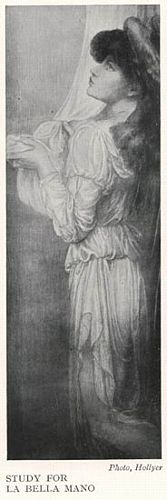
STUDY FOR
LA BELLA MANO
Photo, Hollyer
Figure: Right-hand attendant angel, in the act of offering a towel. Nearly whole-length,
wearing soft drapery; the head is raised in profile to left.Surtees, p. 139

THE PARABLE OF THE VINEYARD
Photo, Mansell
Figure: Seven figures total: three men in medieval clothing planting vines; two women
looking on from upper left; two male figures wearing crowns looking over the fence at upper
right.
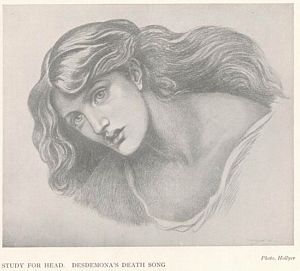
STUDY FOR HEAD. DESDEMONA'S DEATH SONG
Photo, Hollyer
Figure:
Study for head of Desdemona, three-quarters to left, inclined downwards with hair
falling upon the shoulders, eyes looking up, lips parted; drapery indicated.
Probably taken from Mrs. Stillman.
Surtees, p. 151
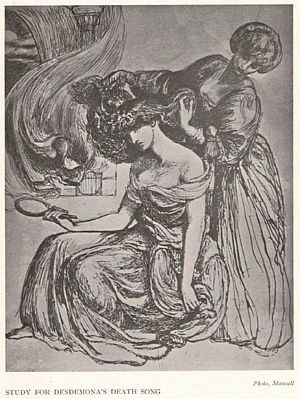
STUDY FOR DESDEMONA'S DEATH SONG
Photo, Mansell
Figure: Desdemona seated and having her hair combed out by Emilia. . . . [Desdemona's] right
arm, holding the looking-glass, is extended forward; her left arm hangs at her side.Surtees, p. 150
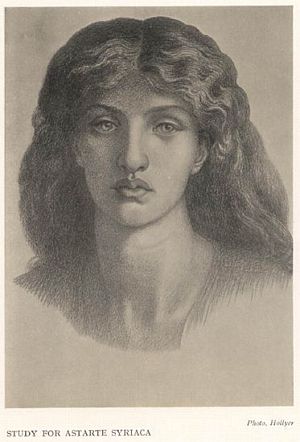
STUDY FOR ASTARTE SYRIACA
Photo, Hollyer
Figure: Full-face head and shoulders of a woman with long, loose, dark hair.
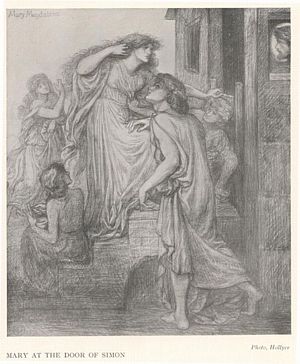
MARY AT THE DOOR OF SIMON
Photo, Hollyer
Figure: Monogram and date lower left corner: ’1870‘ . . . Design for a
large oil-painting, commissioned by Leyland, but never begun. Identical in its composition
to the version of 1858 but for the absence of the fawn and background figures.Surtees, p. 64
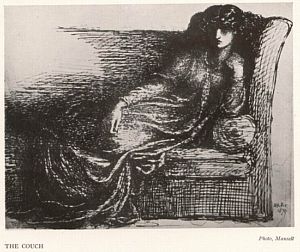
THE COUCH
Photo, Mansell
Figure: Dated lower right: ‘29 Nov. 1870’. On the right end of a sofa
facing to front with her left elbow propped on a bolster, and knees drawn up. Her right
arm is laid at length along the side of her body.Surtees, p. 177
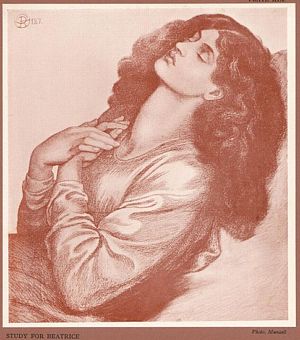
STUDY FOR BEATRICE
Photo, Mansell
Figure: Monogram and date upper left corner: ‘1871’. Study for
Beatrice. Half-length to left; her eyes are closed; hands folded on her breast; the heavy
dark hair falls about her shoulders.Surtees, p. 145
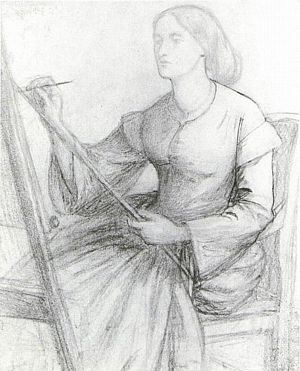
SKETCH OF MISS SIDDAL
Photo, Mansell
Figure: Seated at an easel, turned to the left. In her left hand she holds a mahlstick, and
in her right a paintbrush.Surtees, p. 194
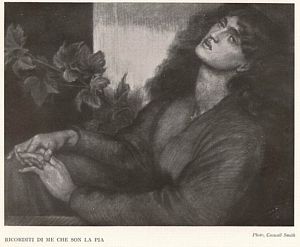
RICORDITI DI ME CHE SON LA PIA
Photo, Caswall Smith
Figure: Here Mrs. Morris is reclining, with head thrown back. The arms lie along the body,
hands claped on the knees, fingering her wedding ring. Foliage in the background.Surtees, p. 119
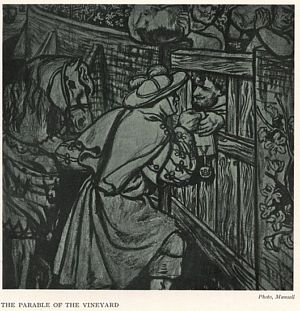
THE PARABLE OF THE VINEYARD
Photo, Mansell
Figure: The head of William Morris is clearly recognizable in the opening of the gate,
wearing ‘a smile of hypocritical civility’. Behind him, two men are
in the act of dropping stones, the right-hand one bearing a resemblance to Gambart the art
dealer, the one on the left to Val Prinsep, and not to Morris as Treffry Dunn suggests.Surtees, p. 83
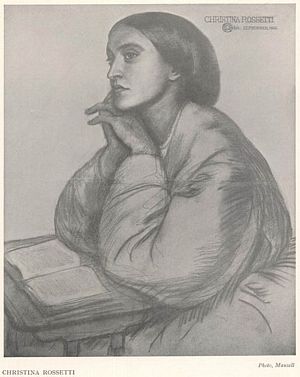
CHRISTINA ROSSETTI
Photo, Mansell
Figure: Inscribed upper right with the sitter's name, monogram and date: ‘del
September 1866’. . . . Over half-length turned to the left, seated at a table
leaning her chin on folded hands; the head is nearly in profile; a book lies open before
her.Surtees, p. 184
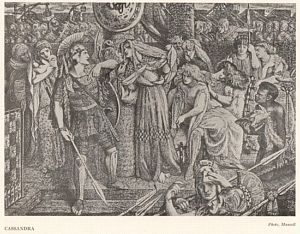
CASSANDRA
Photo, Mansell
Figure: It is an elaborate composition full of power and urgency and not without humour. A
note of pathos is introduced in the whole-length figure of Andromache clutching her naked
baby, and in Hecuba standing on the right, her hands over her ears while Pram tries to
comfort her. Special note should be taken of the pattern formed within the confined space
of the background where Trojan soldiers are marching to battle, forming a design with
their helmets and raised spears more usually provided by Rossetti's angels' heads within
enclosed wings.Surtees, p. 80
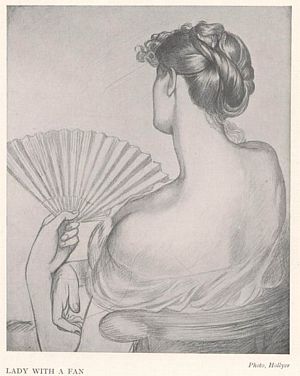
LADY WITH A FAN
Photo, Hollyer
Figure: Half-figure seated, back view, wearing drapery leaving the shoulders uncovered. Her
hair is drawn up and twisted into a chignon, a tendril escaping down the nape of the neck.
She holds a fan in her left hand.Surtees, p. 124
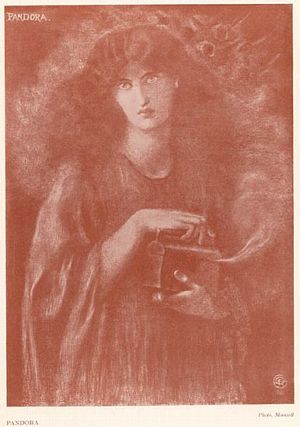
PANDORA
Photo, Mansell
Figure: With both hands she holds the fateful casket encrusted with precious stones . . .
from out of it issues . . . smoke curling upwards round her head, taking the shape of
spirit forms. The head is taken from Mrs. Morris. . . . Monogram and date lower right
corner: ‘1869’.Surtees, pp. 125-6
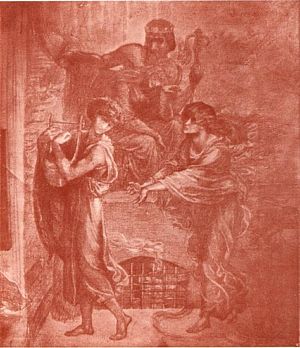
ORPHEUS AND EURYDICE
Photo, Mansell
Figure: The subject is taken from Virgil's descriptions of Orpheus leading Eurydice out of
Hades, over the Styx, and giving the forbidden backward glance. Enthroned behind them are
Proserpine, a shrouded lamenting figure, and Pluto, who draws aside a curtain revealing a
stairway leading up to earth.Surtees, p. 141
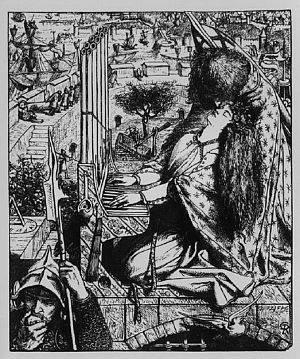
THE PALACE OF ART
Photo, Mansell
Figure: Design for Moxon's illustrated edition of Tennyson's
Poems (1857),
illustrating the lines from
The Palace of Art. . . . In the woodcut the
angel is kissing St. Cecilia on the forehead (as in the Ashmolean version) while here he
is looking down at her.Surtees, p. 48
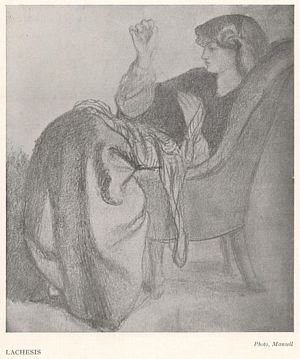
LACHESIS
Photo, Mansell
Figure: A woman [Elizabeth Siddal] seated in a chair in profile to left with her right hand
raised, appears to be unravelling a knitted garment lying on her knees.Surtees, p. 81
Note: Heavy brown laid paper.
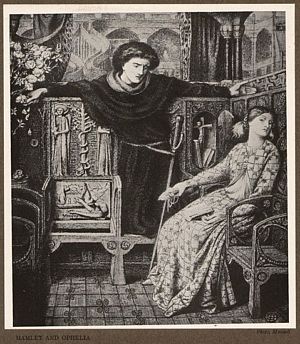
HAMLET AND OPHELIA
Photo, Mansell
Figure: Highly finished drawing . . . illustrating the incident in Act III, Sc. i, of
Shakespeare's play where Ophelia, here seated in a small oratory, is in the act of
returning to Hamlet the letters and presents he has given her. Depicted on the upturned
misericord seat beside him is the death of Uzzah after touching the Ark of the Covenant;
the back panel is as elaborately carved with the Tree of Knowledge encircled by a crowned
serpent; on either side an angel stands with uplifted sword, and in the space between them
is inscribed: ‘Eritis sicut deus [
sic]
scientes bonum et malum.’ (It is of interest to note here that the
decoration carved on the seat corners is the one adopted by the artist for many of his
frames.) From a turret in the upper right corner the King and Queen look down.Surtees, p. 61
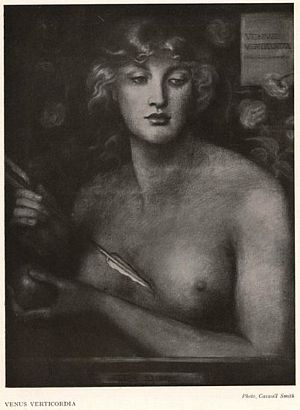
VENUS VERTICORDIA
Photo, Caswall Smith
Figure: Venus stands naked . . . in her hand an apple—the reward of her
beauty—and a dart. . . .Initials and date: ‘AD 1867’ on a
narrow white cartouche, lower centre. Title inscribed on a label upper right. . . . [T]he
figure behind a balustrade stands slightly to the left, the position of the hands being
slightly altered in consequence. The lowered eyes look to right; the hair falls on the
left shoulder. . . . Halo and butterflies omitted, also the flowers, except for a few
roses climbing up the background trellis.Surtees, p. 99
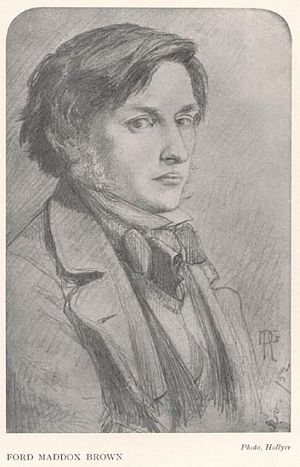
FORD MADDOX BROWN
Photo, Hollyer
Figure: Monogram and date lower right: ‘Nov/52’. . . . Almost
half-length, turned three-quarters to right.Surtees, p. 158
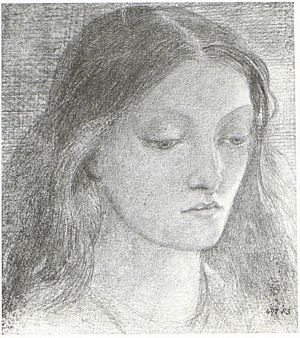
MISS SIDDAL
Photo, Hollyer
Figure: Head with unfastened hair turned three-quarters to right, looking down under heavy
lids.Surtees, p. 195
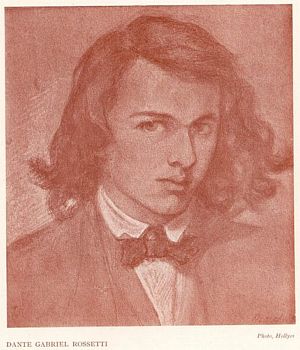
DANTE GABRIEL ROSSETTI
Photo, Hollyer
Figure: Dated lower right: ‘March 1847’. Head and shoulders; the head
turned sligthly to the right, the eyes to front. The hair is long, curling at the ends.Surtees, p. 185
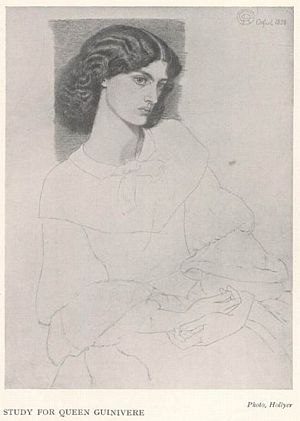
STUDY FOR QUEEN GUINIVERE
Photo, Hollyer
Figure: Monogram and date inscribed upper right: ‘Oxford 1858’. A
study for Queen Guenevere in one of the Oxford Union murals which was not carried out; it
is therefore listed as a portrait. Ten years later Rossetti was to use the same pose for
his studies of Mrs. Morris as Mariana . . . Seated, over half-length, turned to the right,
her left shoulder raised, her hands placed in her lap; only the head, inclined slightly
forward, is finished.Surtees, p. 174
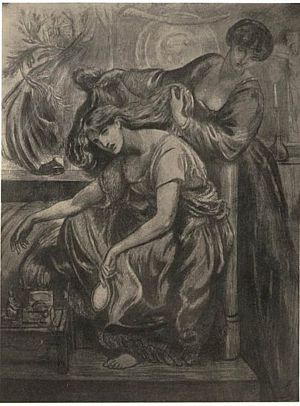
STUDY FOR DESDEMONA'S DEATH SONG
Photo, Mansell
Figure: Desdemona, seated, right arm extended, elbow on her knee, palm facing downward, left
hand holding a mirror. Emilia stands behind her, combing her hair out. Desdemona's bare left
foot is visible. In the background at right are candlestick and a crucifix with a figure of
Christ. N.B.: This drawing does not appear in the Surtees catalogue.
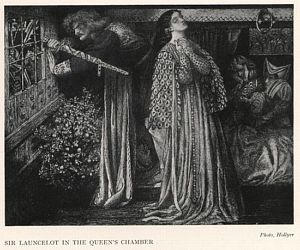
SIR LAUNCELOT IN THE QUEEN'S CHAMBER
Photo, Hollyer
Figure: Launcelot with his sword stands at the window at left; weapons are visible through
the window. Guenevere stands facing away from the window, her hands at her throat. Three
figures cower at right.
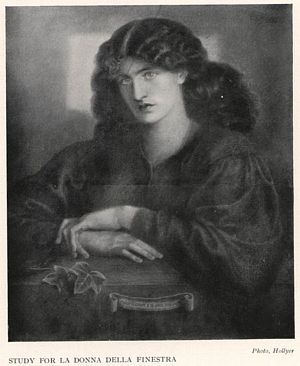
STUDY FOR
LA DONNA DELLA FINESTRA
Photo, Hollyer
Figure: Half-length woman facing front, dark hair down to shoulders, hands folded on a
surface in front of her. Monogram and date upper right corner: ‘1870’. Inscribed on a
scroll in the centre foreground: ‘Color d'amore e di pietà
sembiante’ . . . Study with accessories omitted except for two ivy leaves lying
on the ledge. (From Mrs. Morris.)Surtees, p. 152
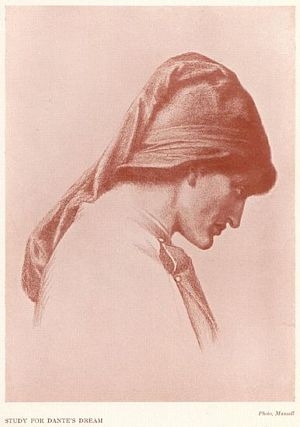
STUDY FOR DANTE'S DREAM
Photo, Mansell
Figure: Study for head and shoulders of Dante; head downturned, wearing a medieval
head-dress. His cloak is buttoned on his right shoulder.Surtees, p. 45
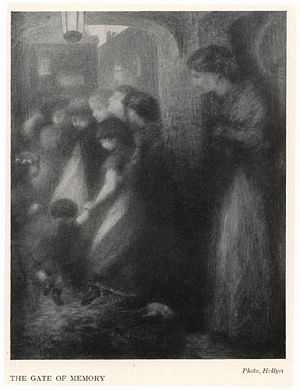
THE GATE OF MEMORY
Photo. Hollyer
Figure: On the right a prostitute stands at dusk under an archway, watching a group of
dancing children, and recognizes herself as once she was in the figure of a seated,
flower-crowned child. An over-hanging lamp casts a dull yellow light upon the children and
illuminates for a moment a large rat as it scuttles out of sight. Fine houses with lighted
windows supply the background to this somber and poignant drawing.Surtees, p. 56
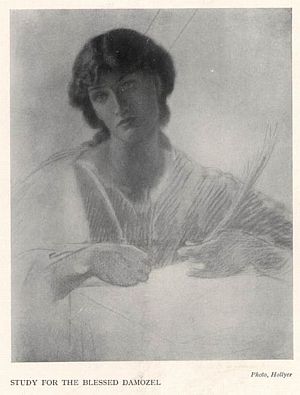
STUDY FOR THE BLESSED DAMOZEL
Photo, Hollyer
Figure: Alternative study for the central figure. Head and bust with hands (of which only
the head of Alexa Wilding is finished) facing to front, the head inclined slightly to
left. The action of the hands is close to that in the painting; a palm branch is roughly
sketched in her left hand.Surtees, p. 143
Note: Heavy brown laid paper.
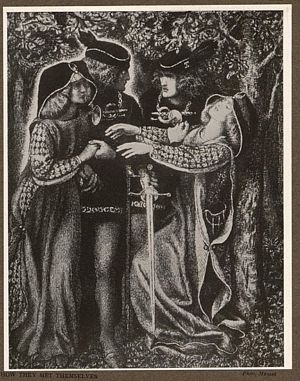
HOW THEY MET THEMSELVES
Photo, Mansell
Figure: monogram and date lower right corner: ‘1851 1860’. . . .
Called by Rossetti the ‘the Bogie drawing’, it ilustrates the legend
of the Doppelgänger which had fascinated him since childhood. A pair of lovers
meet their doubles, outlined in light, in a wood at twilight— a sure presage of
death.Surtees, p. 74
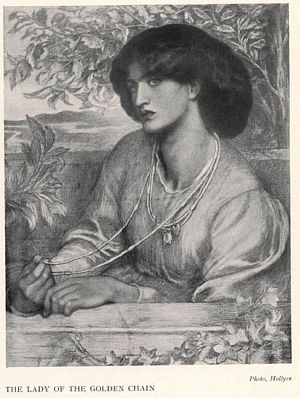
THE LADY OF THE GOLDEN CHAIN
Photo, Hollyer
Figure: Portrait of Mrs. Morris, partly unfinished.Surtees, p. 120
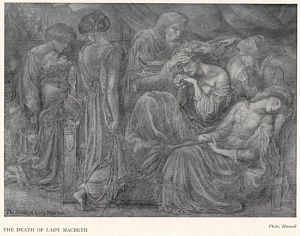
THE DEATH OF LADY MACBETH
Photo, Mansell
Figure: Title inscribed in the lower left-hand corner. Seven figures, including Lady Macbeth
sitting up in a bed at center, her hands clasped in a mad gesture.
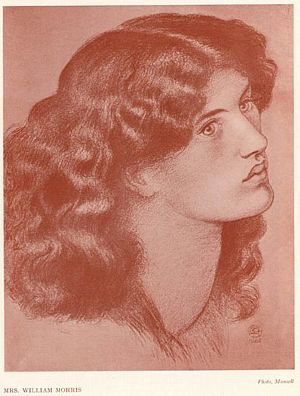
MRS WILLIAM MORRIS
Photo, Mansell
Figure: Monogram and date lower right: ‘1865’. Head upturned,
three-quarters to right; the hair loose about the shoulders.Surtees, p. 175
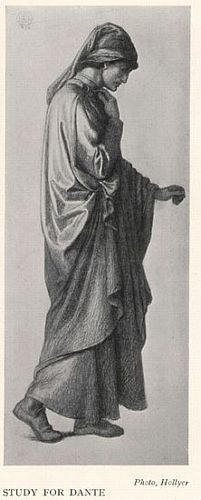
STUDY FOR DANTE
Photo, Hollyer
Figure: Monogram and date upper left corner: ‘1874’. Study for Dante,
most probably for the picture with date added later. Whole-length walking to the right
with his left arm extended and his right raised to his neck . . . his right arm gathers up
his cloak.Surtees, p. 44
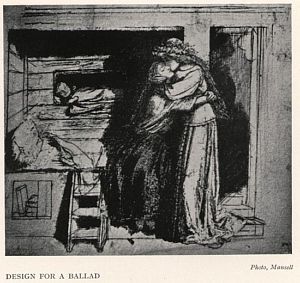
DESIGN FOR A BALLAD
Photo, Mansell
Figure: Two sisters embracing; behind them, a baby lies in a niche in the wall.
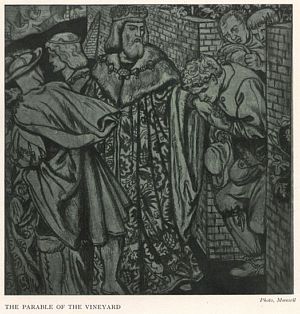
THE PARABLE OF THE VINEYARD
Photo, Mansell
Figure: Six figures in medieval dress; a bearded and crowned figure in a patterned cloak
with a fur collar stands at center; at right is the wall of the vineyard with three figures
within the gate.






































![Image of page [21]](http://www.rossettiarchive.org/img/thumbs_small/s255d.wood.jpg)










